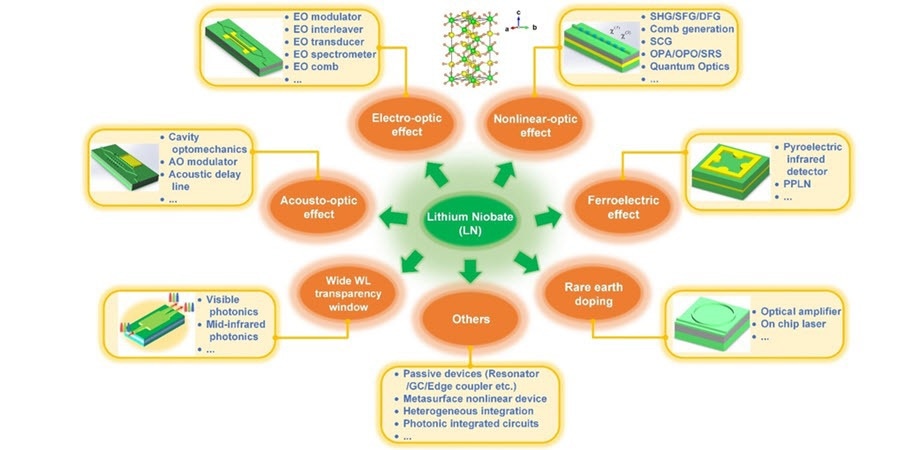Since its ferroelectric feature was initially identified in 1949, lithium niobate (LiNbO3, LN), one of the most significant artificial materials, has been extensively exploited in the photonics field.
 Lithium niobate-based devices covering electro-optic, nonlinear, ferroelectric, acousto-optic, visible, rare earth doping devices, etc. Image Credit: G. Chen et al., doi:10.1117/1.AP.4.3.034003.
Lithium niobate-based devices covering electro-optic, nonlinear, ferroelectric, acousto-optic, visible, rare earth doping devices, etc. Image Credit: G. Chen et al., doi:10.1117/1.AP.4.3.034003.
A broad transparency window (400 nm to 5 m), large electro-optic (EO), nonlinear optical (NLO), acousto-optic (AO), and pyroelectric coefficients, as well as robust chemical and physical properties, are only a few of LN’s advantages compared to other material systems.
Numerous types of photonic devices have been shown based on these principles. For the development of high-speed modulators, for instance, the huge EO feature of LN can be employed.
Light is constrained inside a planar waveguide created by ion-in diffusion or proton exchange in typical bulk LN (planar devices). Although they have been used effectively for decades, bulk LN-based devices have a huge feature size and very low performance because the refractive index contrast in such a technology is often quite modest (~ 0.02).
Since large device sizes and high power are incompatible with the anticipated trends in energy efficiency and integration, the issue of weak index contrast hinders the continued development of LN photonics.
However, due to the development of high-quality thin-film LN (TFLN) with controllable thickness via lapping and polishing and crystal ion slicing (CIS) techniques, this scenario may change.
It is possible to construct an LN on insulator (LNOI) structure, which is akin to a silicon on insulator (SOI), by bonding these high-quality TFLNs to an insulator with a lower refractive index, such as silicon oxide.
The main advantage of LNOI’s huge refractive index contrast is that by patterning structures utilizing different existing etching processes, even smaller devices can be combined on a single chip.
TFLN can also be bonded to other lithographically patterned material platforms, where LN acts as a thin layer of unpatterned film and interacts with the light from waveguides or other devices made in the bonded platform.
High-performance LN-based photonic devices, particularly integrated devices, have progressed quickly in recent years thanks to new processing capabilities, and several alternative topologies for diverse application situations have been shown. An age of LN photonics is highly anticipated.
Recent achievements in LN photonics have been thoroughly reviewed by researchers from the National University of Singapore (NUS), Huazhong University of Science and Technology (HUST), Agency for Science, Technology and Research (A*STAR), and Nanyang Technological University (NTU).
The integrated LN photonics devices that have surfaced recently, as well as a few bulk LN-based devices and associated processing technologies, are all included in this study, which was published in Advanced Photonics. The scientific community will then have a more complete understanding of how LN photonics technology has developed.
Aaron J. Danner, NUS associate professor and senior author of the study, hopes that readers will be motivated by this work and subsequently contribute to the continued advancement of LN photonics on behalf of his group and the fast-developing area of research.
Journal Reference:
Chen, G., et al. (2022) Advances in lithium niobate photonics: development status and perspectives. Advanced Photonics. doi:10.1117/1.AP.4.3.034003.